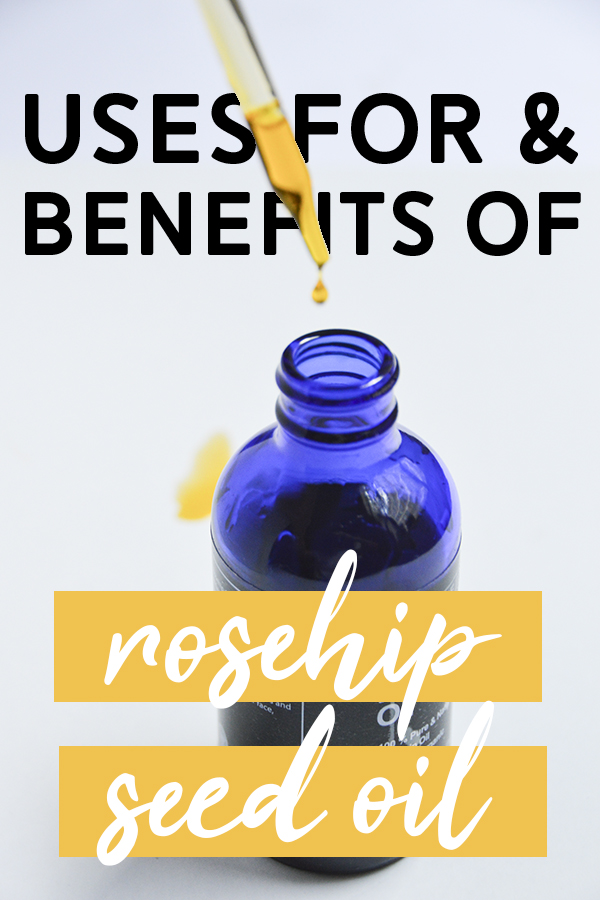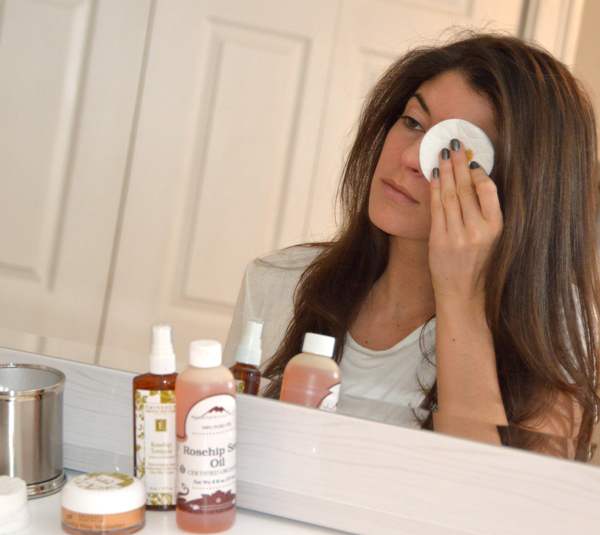
I’ve been using rosehip seed oil practically daily for close to a decade now—I love it! I originally published this post in 2014 and have updated it since completing my Aromatherapy certification. I’m going to go over some of the benefits of rosehip seed oil and then I’ll share the ways in which I incorporate it into my skincare routine.
Rosehip seed oil is extracted from the seeds of the fruit of a rose bush (Rosa mosqueta or Rosa rubiginosa) that grows wild in the southern Andes. It’s considered a carrier oil (not an essential oil). That means you can apply it directly to the skin without diluting it, unlike essential oils. In fact, if you were to make an essential oil blend to apply to your skin, you might want to use rosehip seed oil as the carrier for said blend.
This oil quickly became one of my favorites because the consistency works well with my skin type and it’s particularly great for repairing sun damage and discoloration, which is a major concern of mine seeing as I grew up on a beach, lifeguarded throughout college, and still am an admitted sun worshipper in the summer (I wear sunscreen, don’t yell at me! lol).
Health & Skincare Benefits of Rosehip Seed Oil
Rosehip seed oil is great for any type of regenerative skin care. So think burns, scars, wrinkles, sun damage, fine lines, stretch marks and hyperpigmentation. This is due to rosehip seed oil’s high levels of linoleic (47.4%) and linolenic (33%) fatty acids. It also contains retin A (retinoic acid) which further contributes to regenerative skin care. Let’s break it down without getting too technical:
Rosehip seed oil is:
- A rich source of polyunsaturated fatty acids, linoleic and linolenic acid
- High in vitamins and antioxidants, especially Vitamin C and Vitamin A (retinol)
This means it is great for:
- Speeding up the wound-healing process.
- Reducing wrinkles, fine lines and signs of premature aging.
- Correcting UV damage and countering the drying effects of the sun, like crow’s feet around the eyes and mouth.
- Scar tissue repair. It can help with reducing redness and hyperpigmentation of scars and loosening up fibrous cords.
- Reducing the appearance of burns and stretch marks.
- Hydrating dry skin.
- Evening skin tone in cases of hyperpigmentation, age spots and other minor skin discolorations.
How I Use Rosehip Seed Oil in My Skincare Routine

As a makeup remover. I put a bit on a cotton pad and rub it over my eyelids to remove my eye makeup before washing my face at night. It works just as good as any makeup remover I’ve bought in stores.
In a toner spray. For years I used Rosehip Tonique by Eminence as my toner, after it was recommended for balancing oily skin. They actually don’t make it anymore, but they have a similar Rose Petal Tonique. Due to some recent skin changes (aka rosacea), I’ve now switched to a really simple, gentle floral water for sensitive skin, but I still love the Eminence brand and would recommend it. They also have a Rosehip Whip Moisturizer that I loved. Again, my skin has since changed so I don’t use it today, but when I did, I liked that it’s light enough to apply before putting on makeup, but still leaves your skin feeling hydrated.
In a facial oil. I’ve used different facial oils over the years as my skin needs have changed, but rosehip seed oil as a carrier has been a constant. This is currently the facial oil blend I’m using for my rosacea.
As a moisturizer on its own. I apply rosehip seed oil directly onto my face, neck and chest as a moisturizer. A little goes a long way! A few drops is all it takes, and then I gently press and smooth it into my skin with my fingertips. It can leave a bit of an oily residue, so I don’t do this to my face if I’m going to apply makeup afterwards.
For cuts and scar prevention. I made the fatal mistake of wearing a new pair of heels out one night (dancing + alcohol + new heels = foot homicide) and the result was not pretty. I had a scab on the back of my ankle that was literally like 4 inches thick. Rosehip seed oil can help prevent the formation of scar tissue so I applied it several times a day to my battle wound. The discoloration faded quickly and no scar formed.
Where to Buy Rosehip Seed Oil
There are lots of great brands that sell quality rosehip seed oil. In choosing a supplier, look for oil that’s cold-pressed and organic. Here are three brands I’ve personally used and would recommend:
- Radha Rosehip Seed Oil via Amazon – Organic, cold-pressed and the convenience of Amazon Prime.
- Plant Therapy Rosehip Seed Oil (also available on Amazon) – I love Plant Therapy! Their website is super informative and you can get cashback if you use Ebates. They also have most of their products available on Amazon.
- Mountain Rose Herbs Rosehip Seed Oil – I love MRH but the shipping is costly and slow compared to the convenience of the other two options.
When purchasing, keep in mind that rosehip seed oil has a fairly short shelf life of about 6-9 months. Don’t buy a huge bottle if you’re not going to use it within that time frame! Refrigerating after opening is recommended to extend the shelf life.
Do you use rosehip seed oil? What are some of your other favorite oils for skincare?
xo Nicole
The statements and blends referenced in this post have not been evaluated by the Food and Drug Administration. Products and/or information are not intended to diagnose, treat, cure or prevent any disease. If you are pregnant, nursing, have a medical condition or are taking any medication, consult with your physician before using any essential oil or blend.
I’m a Certified Holistic Aromatherapist through the Institute of Integrative Aromatherapy and only share blends with you that I’ve personally used and from which I’ve benefited. I stand behind them 100%! That being said, essential oil blends are most effective when made with individual needs, goals and personality in mind.
Links to some essential oils and products are affiliate.







